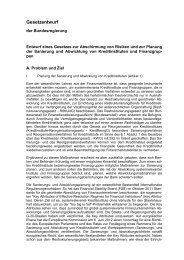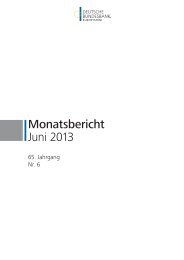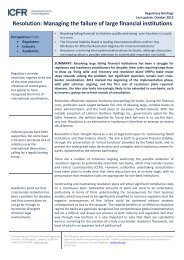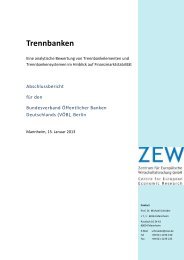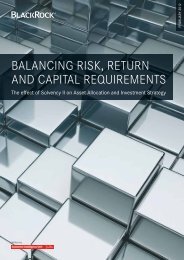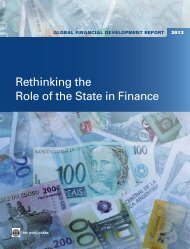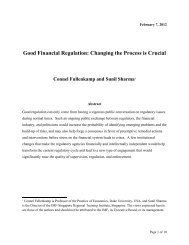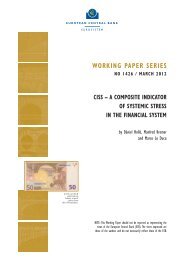3 Issuing costs of state guaranteed bonds - Financial Risk and ...
3 Issuing costs of state guaranteed bonds - Financial Risk and ...
3 Issuing costs of state guaranteed bonds - Financial Risk and ...
You also want an ePaper? Increase the reach of your titles
YUMPU automatically turns print PDFs into web optimized ePapers that Google loves.
3 <strong>Issuing</strong> <strong>costs</strong> <strong>of</strong> <strong>state</strong> <strong>guaranteed</strong> <strong>bonds</strong><br />
possibility that, in addition to the baseline impact <strong>of</strong> <strong>state</strong> guarantees, there is an incremental<br />
effect relating to certain classes <strong>of</strong> bond ratings. Empirically, we add to the main empirical<br />
specification that uses a guarantee (GUARANTEEi) variable <strong>and</strong> a bond rating (RATINGi) variable,<br />
interaction terms between use <strong>of</strong> guarantee <strong>and</strong> bond ratings.<br />
Table 6 presents the results <strong>of</strong> this analysis. The figures represent the total impact <strong>of</strong> <strong>state</strong><br />
guarantees (baseline impact plus rating upgrade effect).<br />
Table 6: Baseline impact <strong>and</strong> ratings upgrade effect, by bond ratings, bps (n=390)<br />
Bond rating Mean 95% lower CI 95% upper CI Range<br />
AAA -37.54 -112.6 37.6 150.2<br />
AA+ 12.24 -61.4 85.9 147.3<br />
BBB+ -147.8*** -262.9 -32.6 230.2<br />
BBB -255.6*** -402.9 -108.3 294.6<br />
BBB- -274.5*** -402.5 -146.5 256.0<br />
Note: <strong>Issuing</strong> <strong>costs</strong> is measured by the z-spread (for fixed rate <strong>bonds</strong>) <strong>and</strong> the zero discount margin (for non-fixed rate <strong>bonds</strong>) based on<br />
the CBBT pricing source. <strong>Issuing</strong> <strong>costs</strong> for each rating is expressed relative to the average reduction across all guarantors based on the<br />
methodology suggested in Suits (1984). Rating classes not shown were omitted from estimation due to multi-collinearity.<br />
State guarantees have a sizeable statistically significant impact on the issuing <strong>costs</strong> <strong>of</strong> <strong>bonds</strong> rated<br />
BBB-/BBB/BBB+, in the order <strong>of</strong> over 200bps. And as might be expected, <strong>state</strong> guarantees had a<br />
relatively small <strong>and</strong> statistically insignificant impact on higher rated <strong>bonds</strong>.<br />
The intuition behind the rating upgrade effect is as follows. An example is a comparison between a<br />
relatively risky bond (e.g. rated BBB) <strong>and</strong> a relatively safe bond (e.g. AAA) that both received <strong>state</strong><br />
guarantees. We might expect a rating upgrade effect for the riskier bond because the <strong>state</strong><br />
guarantee reduces the credit risk embedded within it by more than the baseline <strong>state</strong> guarantee<br />
impact alone. This is less likely to be the case for the safer bond, as receiving a <strong>state</strong> guarantee<br />
may not transform the credit risk embedded in this bond incrementally by as much.<br />
3.5.7 Impacts by bank rating<br />
Following a similar approach to the section above, we estimated the ratings upgrade effect using<br />
bank rather than bond ratings. The baseline impact was estimated to be 47.5bps. However, we did<br />
not find any statistically significant additional impact through the ratings upgrade effect. These<br />
results are shown in Table 7 below.<br />
59



